Employers who hire felons can save money on their federal income taxes through a general business credit called the Work Opportunity Tax Credit (WOTC). The nonrefundable tax credit is worth up to 40% of the first $6,000 paid in wages. If you’re eligible, then you can use this tax credit until it runs out on Dec. 31, 2025.
For the purposes of this credit, a felon is someone who has been convicted of a felony under any federal or state law and has a hiring date that’s less than one year after their date of conviction or release from prison.
Step 1: Have Qualified Felons Complete IRS Questionnaire Before Interview
To apply for this credit, your candidate must first fill out Page 1 of IRS Form 8850, the Pre-Screening Notice and Certification Request for the Work Opportunity Credit. They should complete the information section, and check Box 2, which indicates that they have been convicted of, or released from prison for, a felony in the past year. They should also sign and date Page 1.
Once your candidate has completed Page 1, you’ll need to flip over to the back of the form and complete the information section at the top of the form. You’ll also need to fill in the date that your candidate completed Page 1. You’ll provide this information in the section denoted “Date Applicant Gave Information.” A good practice is to complete this section on the same day your candidate fills out Page 1.
Step 2: Interview the Qualified Felon & Make Your Hiring Decision
Once you have vetted your candidate during the prescreening process, your next step is to interview the candidate for the role and make a hiring decision that’s best for your company. You can learn more about the factors you should consider before hiring a felon in our guide on How to Hire Felons.
If you determine that the candidate is the right fit and are ready to move forward with the hiring decision, you’ll also have some more work to do on Form 8550. On Page 2, you’ll need to fill in the dates for when the job was offered, candidate was hired, and candidate started their job.
After you finish this section, you’ll need to sign under penalty of perjury that the applicant gave you the information on this form on or before the day the job was offered and that the information you gave is—to the best of your knowledge—true, correct, and complete. Based on what the job applicant said on Page 1, you think the person is part of a group that’s being targeted, and you now hereby request certification that the individual is a member of a targeted group.
Step 3: Apply for Certification From Your State Workforce Agency
Now that you have Form 8550 all completed and signed, you’re ready to apply for certification. To complete your application, you will need the following form, in addition to Form 8850:
- United States Department of Labor (DoL) Form 9061, Individual Characteristics Form (ICF) Work Opportunity Tax Credit
- Any documentation that needs to be attached to 9061 to prove the felony, such as parole officer’s name, correctional institution records, or extracts from court records
Ex-felons can complete Form 9061 by checking the “yes” box next to Question 17, indicating that your new hire was convicted of a felony or released from prison after a felony conviction during the year before you hired them. Then, indicate the date of conviction, the date of release, and whether it was a federal or state conviction.
Once you have Form 9061 completed and the required information attached, you’ll need to mail it to your state workforce agency. These agencies may have different names, but they all usually offer training, job, career, and business services, as well as programs for unemployment insurance, programs for veteran reemployment, and information about the job market.
If you’re unsure where the workforce agency is in your state, the DoL has a complete list of WOTC State Coordinators. You can reach out and ask where to mail your application.
Step 4: Calculate the Credit for Hiring Felons
Once you receive the state certification that your employee qualifies as a felon, you must calculate and report the credit on your return. The credit is usually worth $2,400 per employee if they worked at least 400 hours. You’ll calculate your credit using IRS Form 5884.
For new hires who are ex-felons, you’ll determine how much of their salaries qualify for WOTC and what percentage of their salary can be used on either line 1 (a) or 1 (b).
- Use Line 1 (a) if the employee worked at least 120 hours but less than 400 hours. Enter the lesser of $6,000 or the wages paid during the year, and then multiply the figure by 25%.
- Figure your credit on Line 1 (b) if your business paid qualified first-year wages to a felon who worked for you at least 400 hours during the year. Enter the lesser of $6,000 or the actual wages paid, and then multiply the figure by 40%.
You’ll use Line 2 to calculate the allowable amount of your credit. Lines 3, 5, and 6 will generally be left blank.
Step 5: Report the Felon Tax Credit on Your Tax Return
For sole proprietors and C corporations (C-corps), this credit will then flow to IRS Form 3800, and you’ll claim it as part of the General Business Credit. S corporations (S-corps) and partnerships will report the credit on Schedules K and K-1. The owners or partners will then claim the credit on their individual returns.
Your allowable portion of the general business credit will be reported on one of the following forms:
Entity Type | Where to Report |
|---|---|
Sole Proprietor | IRS Form 1040 or 1040 SR, Schedule 3, line 6a |
C Corporation (C-corp) | IRS Form 1120, Schedule J, Part I, line 5c |
S Corporation (S-corp) | IRS Form 1120-S, Schedule K, line 13g |
Partnership | IRS Form 1065, Schedule K, line 15f |
Example of How to Claim the Tax Credit for Hiring Felons
Step 1: Jane Completed the IRS Questionnaire Before Interview With Jim
Jane contacted Jim, the owner of Best Construction Projects LLC, on December 20, 2021, wishing to apply as a foreman. On the same day, Jim invited Jane down to his office so that they could talk more about the job. When Jane arrived, Jim gave Jane a job application and IRS Form 8850 so that she could complete Page 1.
Let’s take a look at how she filled out the form.
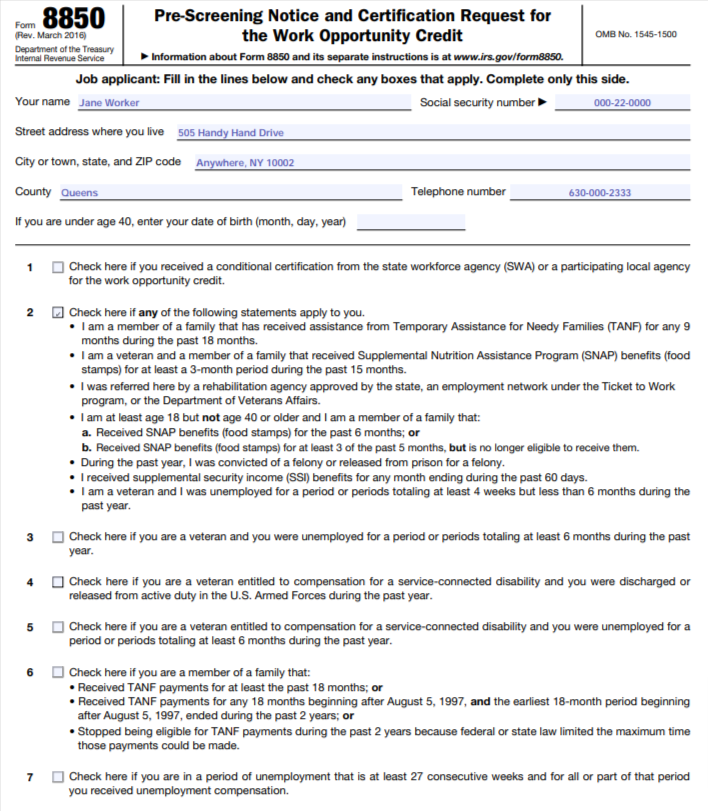
Filled-out sample of IRS Form 8850 Page 1
Jane checked box 2 because bullet point 5 applied to her given her recent felony conviction. Once she completed Page 1, she handed the form over to Jim, who completed the information section on Page 2 and also filled in the date that Jane gave him the information (shown in image in Step 2).
Step 2: Jane Is Interviewed & Jim Made His Hiring Decision
On Dec. 22, 2022, Jim called Jane back down to his office to interview her for the position. The interview went well, and Jim decided to offer her the position, earning $60,000 per year on Dec. 23, 2022. Jim gave Jane a start and hire date of Jan. 1, 2023.
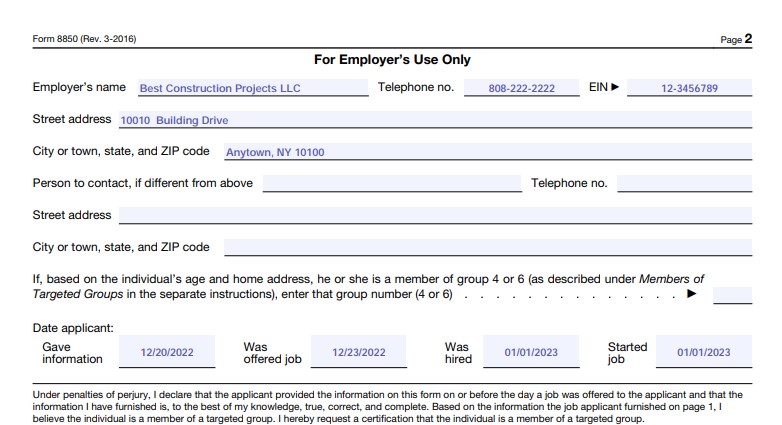
Completed sample of IRS Form 8850 Page 2
Step 3: Jim Applies for Certification From His State Workforce Agency
Jane started her new role on Jan. 1, 2022, and Jim wanted to complete the certification process right away, so he gathered Form 9061, Individual Characteristics Form (ICF) Work Opportunity Tax Credit, as well as Jane’s records from her former correctional facility.
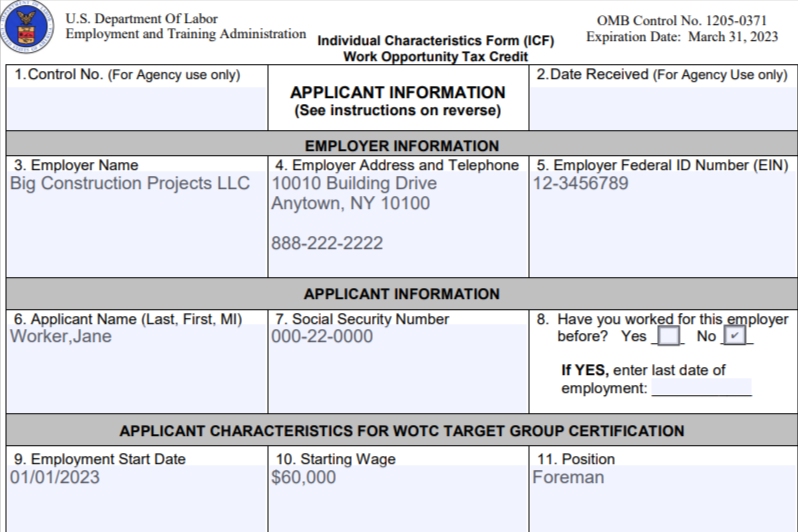
Example of a filled-out IRS Form 9061
On Form 9061, Jane only completed question 17 because it’s the only one that applies to felons. She also signed the bottom of the form under penalty of perjury.

A sample of Form 9061’s Question 17 filled in
Jim gathered all the information and immediately mailed it to his state workforce agency on Jan. 2, 2023.
Step 4: Calculate the Credit for Hiring Felons
The state of New York certified Jane as a qualified felon, so for 2023, Jim will be eligible to claim the credit on his return. Since Jane is a full-time employee, Jim estimates that she’ll work well over 400 hours during the tax year.
Let’s use Form 5884 to calculate Jim’s projected amount of WOTC.
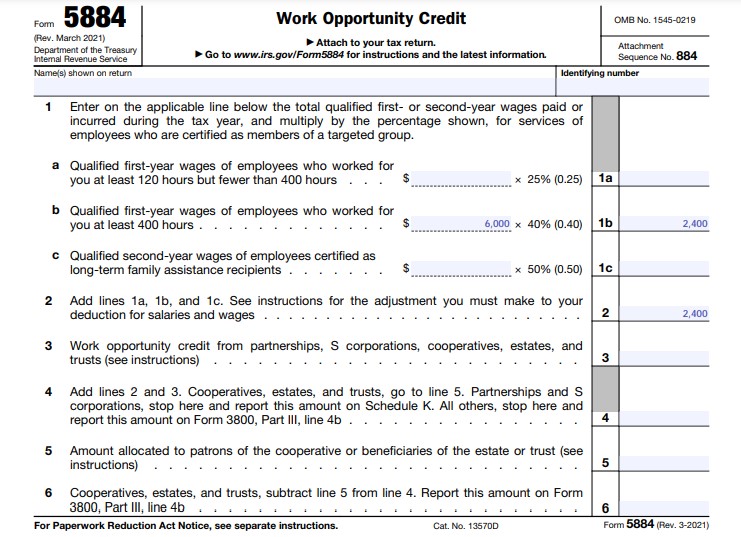
Calculating Jim’s WOTC for 2023 on IRS Form 5884
Step 5: Report the Tax Credit on Your Tax Return
The amount figured on IRS Form 5884 is then carried over to Part III of IRS Form 3800, line 4b. Since Jim is a sole proprietor, he’ll claim this credit on IRS Form 1040, Schedule 3.
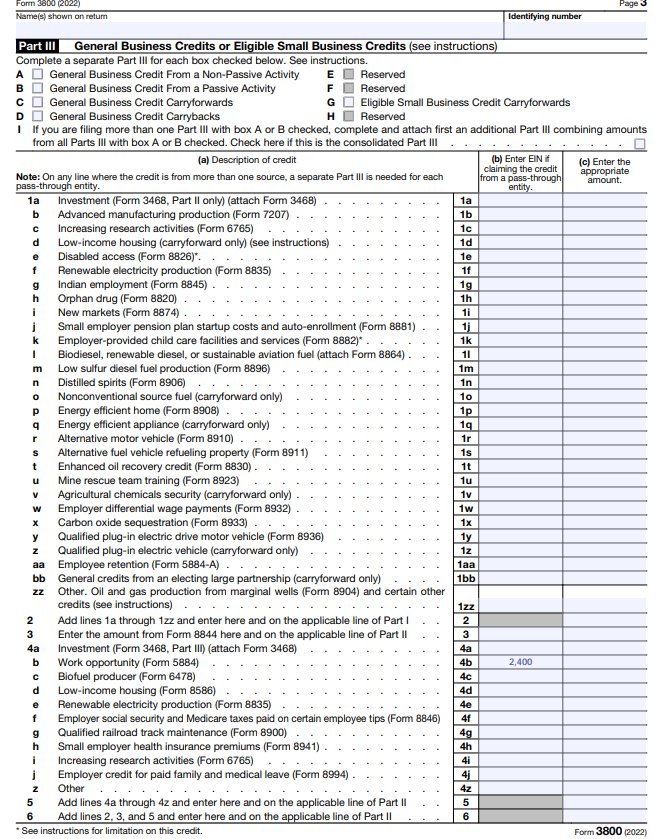
Jim’s completed IRS Form 8300
Frequently Asked Questions (FAQs)
No, they don’t. What’s commonly referred to as the “felon tax credit” is a tax credit for employers of people previously convicted of felonies.
Yes, any unused WOTC can be carried back one year and then forward for 20 years on IRS Form 3800.
No, you can’t. Family members, former employees, and undocumented immigrants cannot qualify you for the WOTC.
Bottom Line
If you’re an employer offering an ex-felon a second chance, you don’t want to miss out on the opportunity to claim this tax credit. You can claim a credit of up to 40% of eligible wages all while helping your community.